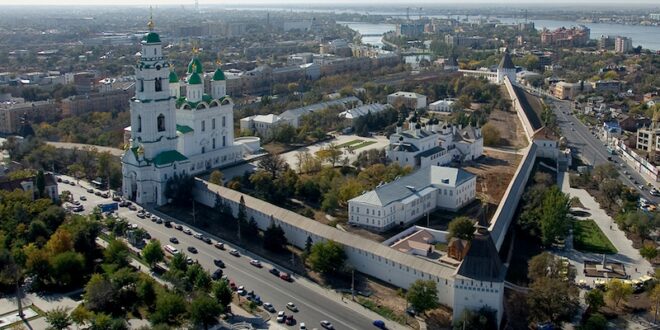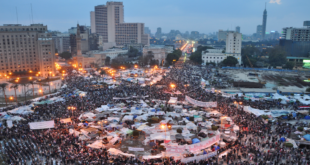Eight years after a dry run for the International North-South Transport Corridor (INSTC) was conducted between Mumbai and Astrakhan via Bandar Abbas, the Russian authorities are keen to convert this corridor into a significant logistics artery. The centrepiece of such plans is to make Astrakhan, a city about 100 kilometres north of the Caspian Sea, a gateway for Indian products to Russia and Central Asia.
During a May visit to the city that lies on two banks of the Volga River, Russian Transport Minister Vitaly Savelyev said Russia was forced to look for new logistics corridors on account of western sanctions.[1] The INSTC, with its access to the three ports of Olya, Astrakhan and Makhachkala, is one of the most important, he added. This, as President Putin stated[2] at the 6th Caspian Summit on June 29 at Ashgabat, Turkmenistan, is “a truly ambitious project, a 7,200-kilometre-long transport artery from St Petersburg to ports in Iran and India.”
The port city of Astrakhan, located at the intersection of Iran, Russia and Central Asia, holds the key to the smooth functioning of the INSTC. Its connections with India go back centuries. It hosted a small but vibrant Indian trading community from the 16th to the 19th centuries and has witnessed a major urban revival over the last decade. Its 16th-century fortress, Astrakhan Kremlin, and several other buildings from the 18th and 19th centuries have been tastefully restored, giving the city of about 6,00,000 inhabitants the feel of a 19th-century European boom town. Astrakhan also hosts Mir Business Bank, a 100 per cent wholly-owned subsidiary of Bank Melli Iran, and an international student community from Caspian littorals like Turkmenistan, Azerbaijan and Iran.
For long a crossroads between north, south, east and west, the inhabitants of Astrakhan reflect the ethnic diversity of the region, proudly calling it a melting point of ethnicities. The sight of a few locals with partly Indian features reminds a visitor of the time when Astrakhan hosted a proper settlement of traders from Punjab, Rajasthan and Sindh. An early 18th-century building called the Indian Trading Compound survives to this day in Astrakhan. In the compound, traders sold furs, copper, leather, carpets, wool, frankincense, precious stones and cotton. They were exempt from paying taxes and duties and had the backing of the Russian Tsars[3]. At its peak, the Indian community numbered 300, including labourers and even sadhus. Their assimilation began when they married Russians or Tartars.
Now, Astrakhan looks to welcome a new generation of Indian businesses, including logistics companies, to service the INSTC. However, the city’s current infrastructure is inadequate to make it a significant economic and logistics hub at the moment. Its compact but well-maintained airport handles little international traffic, with most of its flights outside Russia headed to a handful of former Soviet cities such as the Caspian city of Aktau in Kazakhstan, Osh, Kyrgyzstan and Baku, Azerbaijan. During the tourist season, airlines operate charter flights to Egypt and Turkey, which are not meant for business travellers.
The city lies on the 4,237-kilometre-long Privolzhskaya Railway Line, which connects Volgograd in European Russia to the Caspian port of Olya. Although the idea of the INSTC was first proposed in the early 2000s, this railway line still had single-track sections until 2021. It now has double tracks up to European Russia and Kazakhstan but remains underused for passenger and freight traffic. Passing essentially through the uninhabited steppes of the Astrakhan region, the tracks can easily be widened to accommodate additional rail freight, but the Russian authorities are more focused on using the Volga-Don Canal, which was opened in 1952 to move freight.
Of course, China has a presence in Astrakhan. Its CCCC Dredging Group Co. Ltd. is dredging the canal to ensure it has a depth of 4.5 metres allowing ships with a larger cargo capacity to enter Russian ports and expanding cargo traffic[4].
Russian companies are hard at work in the region too. Earlier in June, St. Petersburg-based Global Ports’ terminal[5] started handling a new container service from St. Petersburg to Nhava Sheva. The service, operated by Russian transport and forwarding company Modul, will use the INSTC with its ships crossing the Caspian from Olya to Anzali in Iran and then to Bandar Abbas before heading to India’s western port of Nhava Sheva. Astrakhan would be the biggest beneficiary of this route as it would act as a transhipment hub from the Volga to the Caspian.
Russia’s plans for Astrakhan are ambitious. At the St. Petersburg International Economic Forum in June this year, the region’s governor Igor Babushkin spoke[6] of a “Caspian Cluster,” a special economic zone project by the Caspian coast to attract investments from India and Iran.
To realise them, Russia must keep to its promises to upgrade the Caspian ports. There are regular reports in the Russian media of ships running aground on Russia’s Caspian coast on account of the sea becoming shallower because of climate change.[7] An Astrakhan region official, who requested anonymity, explained that low water levels pose a threat to the long-term viability of the strategically important port of Olya.
“If the Moscow-backed major infrastructure projects see the light of day, then Astrakhan can truly become one of Russia’s biggest engines of economic growth,” the Astrakhan official said. Unlike previous initiatives to boost Russia-India trade, the development of the INSTC is likely to bring about tangible results since, under the current sanctioned circumstances, Moscow has no choice but to reorient its trade with countries like India. Astrakhan would become India’s entry point and central trading hub in Russia.
 Eurasia Press & News
Eurasia Press & News



